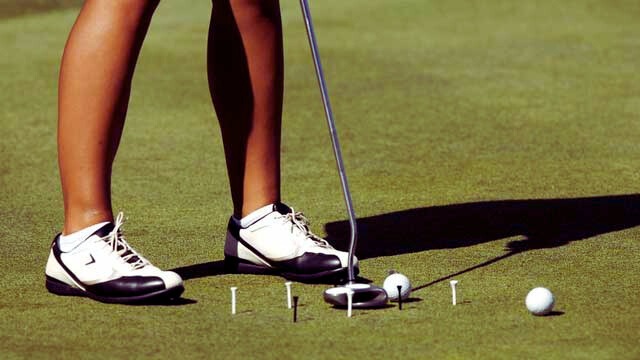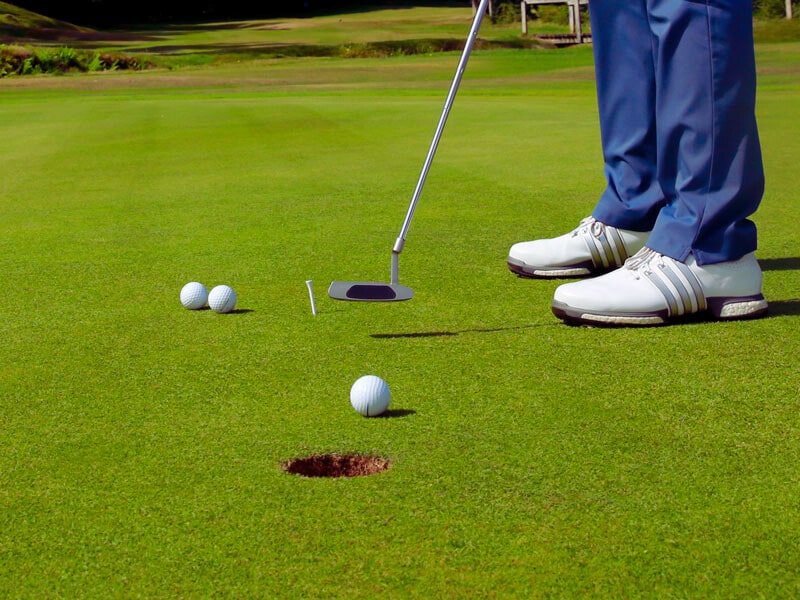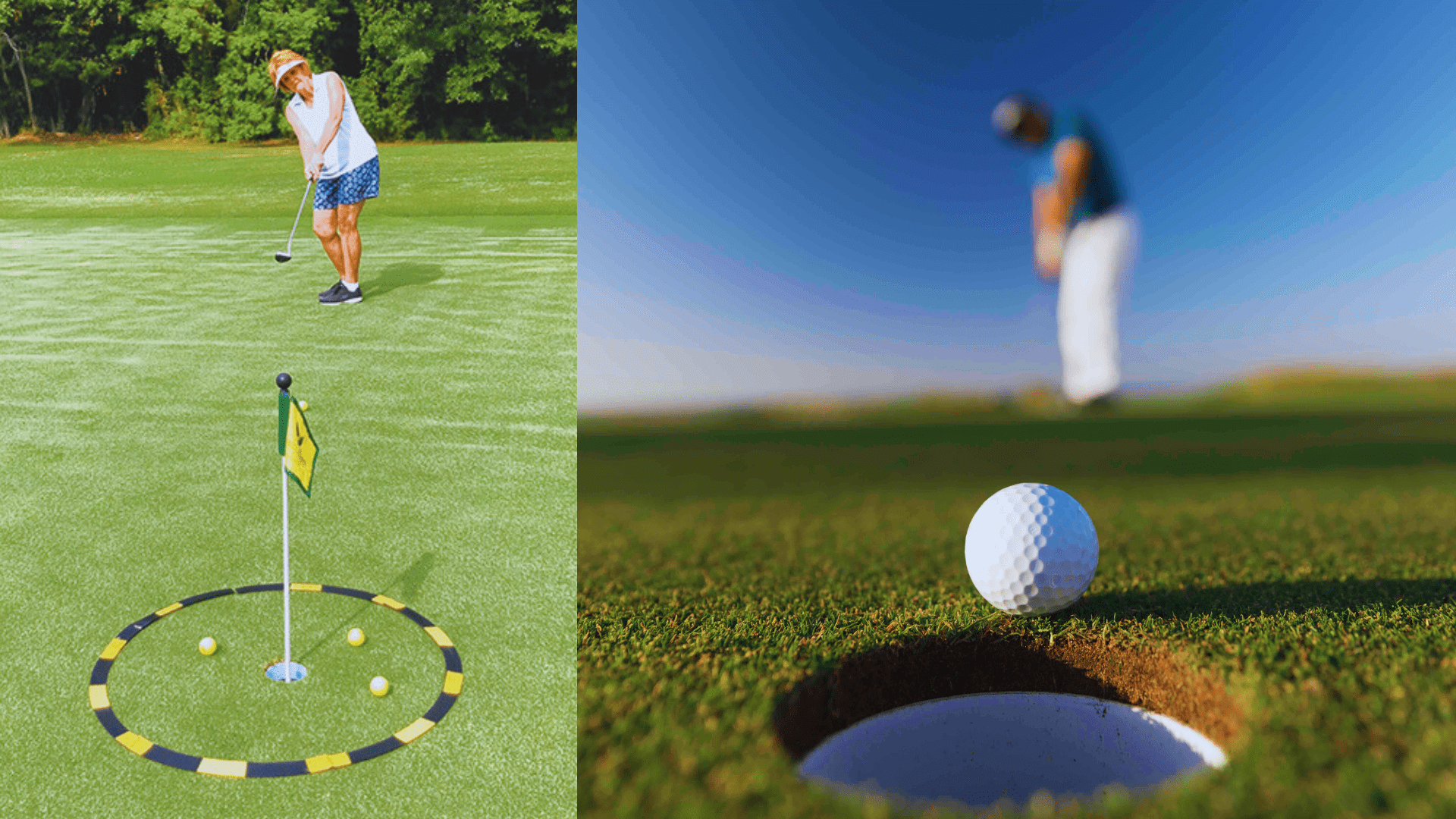Lag-putting is a fundamental technique in golf, especially important when approaching the green from a long distance. The primary goal of a lag putt isn’t necessarily to make the ball in one stroke but to get the golf ball as close to the hole as possible, ideally setting up an easy follow-up putt. This approach reduces the risk of overshooting the hole or leaving too much distance for the next putt, which can lead to higher scores.
Lag putts are particularly valuable in managing long greens or when dealing with tricky slopes and contours that make precise putting challenging. The technique requires not only a good understanding of the green’s topography but also control over the putt’s power and direction. Mastery of lag putting can significantly impact a golfer’s efficiency on the green, contributing to better overall scores and more consistent gameplay.
Understanding Golf Putting
The Basics of Putting

Putting is a critical aspect of golf, focusing on rolling the golf ball on the green towards the hole using a club called a putter. The fundamentals of putting involve several key elements:
- Grip and Stance: The grip should be gentle to maintain feel and control without excessive pressure. Your stance should be stable, with feet approximately shoulder-width apart, allowing for a balanced and controlled putting stroke.
- Alignment: Proper alignment is crucial. Golfers should ensure their feet, hips, and shoulders are parallel to the intended putting line. The eyes should be directly over the ball to ensure a correct line of sight and improve accuracy.
- Putter Face and Ball Position: The putter face must be square to the intended line at impact for accuracy. The ball should typically be positioned slightly forward in your stance to ensure that the putter strikes the ball with a slight upward motion, promoting a better roll.
- Stroke: The putting stroke should be smooth and pendulum-like, moving primarily with the shoulders while the wrists remain stable. The motion should be back and through along the same line, maintaining a consistent speed throughout.
- Reading the Green: Successful putting requires reading the green effectively, which involves assessing the contours, slopes, and grain of the green to predict the ball’s path and speed. This skill develops with experience and practice.
By mastering these fundamentals, golfers can improve their precision on the greens, leading to lower scores and more successful rounds of golf.
Importance of Putting in Golf
Putting is crucial in golf for several reasons, highlighting its role as a key component in determining a player’s score and overall success in the game:
- Scoring Impact: Putting typically accounts for about 40-50% of a golfer’s strokes in a round. Efficient putting can significantly reduce the total score, making it one of the most impactful aspects of the game.
- Game Finishing: Most golf holes conclude on the putting green, meaning the final strokes that determine the score for each hole are usually putts. Effective putting can compensate for less precise play earlier in the hole.
- Pressure Handling: Putting often involves high-pressure situations, especially in competitive play. The ability to maintain composure and execute effective putting strokes under pressure can distinguish between winning and losing.
- Skill Longevity: Unlike the physicality required for long drives, putting skills can be maintained, or even improved, as players age, allowing older players to remain competitive.
- Minimal Equipment: Putting doesn’t require a range of clubs or physical prowess that other aspects of golf might. This accessibility means that refining putting skills is a practical way for golfers of all skill levels to improve their game.
In summary, mastering the art of putting is essential not only for scoring well but also for capitalizing on opportunities to win games and tournaments, regardless of a player’s overall physical ability or driving range.
The Concept of Lag Putting
When to Use a Lag Putt

Lag putting is a strategic approach used primarily to control the ball’s distance to ensure it ends up close to the hole, minimizing the risk of a follow-up putt. Here are typical situations where lag putting is most beneficial:
- Long Distance from the Hole: When the ball is significantly far from the hole, especially more than 25 feet, a lag putt is useful to bridge the distance safely and avoid over-hitting the ball.
- Challenging Green Conditions: On greens with complex contours, slopes, or exceptionally fast or slow surfaces, a lag putt helps manage the unpredictability of the ball’s path and speed.
- Defensive Strategy: In competitive situations where securing a par is crucial, and the risk of a three-putt could be costly, lag putting is employed to ensure that the ball remains in a manageable position.
- High Stakes: In high-pressure moments, such as the final holes of a tournament where maintaining a lead or staying close to the leaders is essential, lag putting can be a safer choice to avoid costly mistakes.
- Unfavorable Weather Conditions: Windy or wet conditions can affect the ball’s roll significantly. Lag putting under such circumstances helps to mitigate these factors, aiming for a closer second putt rather than risking going too far past the hole.
Using a lag putt strategically can effectively reduce the chances of scoring higher on a hole and is a crucial skill in managing golf courses smartly and efficiently.
Techniques for Effective Lag Putts
Lag putting is a crucial skill in golf, aimed at getting the ball close to the hole from a long distance to set up an easy next putt. Here are effective techniques to perform lag putts:
- Focus on Distance Control: The primary goal of a lag putt is to control the distance rather than aiming directly for the hole. It’s important to develop a feel for how hard to hit the ball depending on the putt’s length and the green’s conditions.
- Maintain a Consistent Stroke: Ensure your putting stroke is smooth and consistent. Avoid decelerating; follow through with the same speed with which you start your stroke. This helps maintain control over the distance the ball travels.
- Aim to Miss High: When you miss a putt, try to do so on the high side of the hole. Putts that miss low tend to travel farther past the hole, increasing the distance of your next putt.
- Practice with Purpose: Regular practice from different distances and on various green conditions is essential. Practice putts that roll just past the hole to build a precise sense of pace.
- Understand Green Conditions: Reading the green is vital. Take into account factors like slope, grain, and wind conditions which can all affect the speed and direction of the putt.
- Use Visual and Physical Cues: Some golfers find it helpful to visualize the path to the hole or to use physical markers during practice to gauge distances more accurately.
By focusing on these techniques, golfers can enhance their ability to execute lag putts effectively, reducing their scores by minimizing three-putts and other costly errors on the greens.
Benefits of Lag Putting
Reducing the Number of Putts

Lag putting effectively reduces the total number of putts per round by minimizing the risk of missing the second putt. Here’s how lag putting achieves this:
- Minimizes Three-Putts: The primary goal of lag putting is to leave the ball close enough to the hole to ensure a comfortable second putt. By focusing on getting the ball within a manageable distance, you significantly reduce the chances of three-putting.
- Improves Distance Control: Effective lag putting helps golfers develop better distance control, which is crucial on greens with varied contours and speeds. By mastering how hard to hit the ball over long distances, golfers can adjust more accurately to different greens, leading to fewer putts overall.
- Builds Confidence: Successfully lagging a putt close to the hole from a long distance can boost a golfer’s confidence. This confidence can translate into more relaxed and focused putting strokes, even in high-pressure situations, leading to better overall putting performance.
- Practice and Consistency: Regular practice of lag putting builds muscle memory and a better feel for greens. This consistency is key to reducing the number of putts in actual play by consistently getting the ball closer to the hole, regardless of the initial distance.
By focusing on these aspects of lag putting, golfers can reduce their overall putt count, improving their scores and the efficiency of their game.
Improving Score
Lag putting significantly impacts a golfer’s score by reducing the likelihood of dropping strokes on the green. Here’s how it directly influences overall scores:
- Reduces Three-Putts: By aiming to get the ball close to the hole, even if not making it in one putt, lag putting greatly diminishes the chances of three-putting. Each avoided three-putt saves at least one stroke per hole.
- Enhances Putting Confidence: Consistently getting the ball close to the hole with a first putt builds confidence in one’s putting game. This confidence can translate into fewer putts per round, thereby lowering scores.
- Improves Stroke Average: Effective lag putting helps maintain or improve a golfer’s stroke average over time. This technique keeps scores lower and more consistent by avoiding penalty strokes that come from misjudged putts, especially in pressure situations.
By focusing on getting the ball close from a distance, lag putting not only prevents score-increasing mistakes but also enhances a player’s ability to manage the greens more effectively during rounds.
Challenges in Lag Putting
Common Mistakes

Lag putting, essential for minimizing strokes on the green, often sees several typical errors among golfers:
- Misjudging Speed: One of the most common errors in lag putting is incorrect speed control. Golfers either hit the ball too hard or not hard enough, leading to long follow-up putts or even a three-putt scenario.
- Over-focusing on the Hole: Focusing too intently on the hole can detract from paying attention to the strength and direction needed for an effective lag putt. A recommended technique is to focus less on the hole and more on the desired stopping area of the ball.
- Ignoring the Green’s Contour: Not accounting for the slope or grain of the green can lead to misdirected or improperly paced putts. Understanding how the ball will roll on the specific terrain of the green is crucial for successful lag putting.
- Lack of Practice: Many golfers do not spend enough time practicing lag putting, leading to inconsistent performance during actual play. Regular practice focusing on distance control and reading greens is essential to mastering lag putting.
By addressing these common mistakes, golfers can significantly improve their lag-putting skills and overall performance on the greens.
Tips for Improvement
Improving lag putting, crucial for minimizing strokes on the green, can be achieved through a few strategic practices:
- Practice Long Putts: Begin your practice with very long putts to get a feel for the green’s overall speed. This helps in understanding how much force to apply depending on the putt’s distance and the green’s conditions.
- Manage Expectations: Set realistic goals such as keeping your putt within 10 percent of the putt’s original distance. This reduces the pressure and helps focus on achievable targets.
- Avoid Excessive Hip Movement: Minimize hip rotation and excessive weight shifting during the putt. Keeping your lower body stable can greatly improve the accuracy and consistency of your putts.
- Assess the Green from Multiple Angles: Instead of just viewing the putt from behind the ball, walk around to different sides to get a better understanding of slopes and distances. This can improve your depth perception and decision-making.
By incorporating these tips into your practice routine, you can significantly enhance your lag-putting skills and performance on the greens.
Learning and Practice
Drills for Better Lag Putting

To enhance lag putting, specific drills can be effective in building consistency and accuracy. Here are some targeted practices:
- Practice from Various Distances: Engage in putting from different distances to better understand how force affects the ball across varying lengths. A key technique is to putt without watching the ball, instead predicting whether it will stop short, long, or in the hole as it moves.
- Ten-Pace Putt Practice: From ten paces away, practice putting to get the ball to roll just one foot past the hole. This drill is excellent for honing your sense of pace, especially for medium-length putts.
- High Side Miss Practice: Focus on missing your putts on the high side of the hole. This technique reduces the likelihood of the ball rolling too far past the hole, as missing low typically results in a longer remaining putt.
- Keep Putts within 10 Percent: Aim to keep your lag putts within 10 percent of the total distance. This simple rule helps in maintaining control over putt length and ensures closer proximity to the hole on misses, making the next putt easier.
These drills help in mastering distance control and accuracy, which are critical for successful lag putting.
Mental Aspects of Lag Putting
The psychological factors affecting lag putting are crucial in golf, influencing performance significantly. Here are some key mental aspects to consider:
- Confidence: Belief in one’s ability to execute a good putt is foundational. A lack of confidence can lead to overthinking the stroke or doubting the chosen line and speed.
- Focus: Concentration is essential in lag putting. Distractions or loss of focus can result in poor judgment of speed and direction.
- Visualizing Success: Before executing the putt, visualizing the ball’s path to the hole can help align mental and physical actions. This practice encourages a positive outlook and precise execution.
- Stress and Pressure Management: The ability to handle pressure situations, like making a crucial lag putt, affects outcomes. Practicing mindfulness and deep-breathing exercises can help maintain calm and focus during the game.
- Routine Consistency: Developing a consistent pre-putt routine helps stabilize the mental state and prepares the body and mind for a successful putt. This routine can include reading the green, aligning the putt, and taking practice swings.
- Adjusting Expectations: Understanding that not every long putt will end close to the hole can prevent frustration and maintain a positive mindset throughout the round.
These mental skills are as important as physical techniques and should be nurtured through practice and mental conditioning.
Professional Insights
Interviews with Golf Pros
Interviews with professional golfers often provide valuable insights into their techniques, mental strategies, and experiences on the tour. Here are some common themes and insights shared by golf pros in various interviews:
- Technique and Practice: Pros often discuss their rigorous practice schedules and the technical aspects of their game, such as swing mechanics and precision in putting. They emphasize the importance of consistent practice and sometimes share specific drills that have helped them excel.
- Mental Game: Many golfers talk about the psychological challenges of golf, such as handling pressure and maintaining focus during tournaments. They might share techniques for mental toughness or how they handle nerves and stress.
- Equipment Choices: Interviews often delve into the types of clubs and balls used by professionals, along with any personal preferences and the reasons behind those choices. This can include discussions about customization and technology in golf equipment.
- Tour Life: Pros may discuss what life is like on the tour, including travel, training, and balancing professional commitments with personal life.
- Personal Stories: Many interviews highlight personal anecdotes and stories from tournaments, providing insights into the personalities and lifestyles of professional golfers.
These interviews can be found in sports magazines, specialized golf publications, podcasts, and sports sections of newspapers.
Concluding Thoughts
Lag putting is a crucial skill in golf, primarily focused on controlling the distance to minimize the chances of a three-putt and ideally leaving the ball close enough for a stress-free second putt. Here are some key takeaways:
- Technique and Consistency: Proper technique, including posture, setup, and stroke, is foundational. Ensuring consistent contact and a smooth stroke helps in accurately gauging the distance.
- Mental Strategy: Confidence and a positive mindset are vital. Viewing the lag putt as an opportunity rather than a challenge can significantly improve outcomes. It’s about minimizing risk and being strategic about where the ball will stop relative to the hole.
- Practice Makes Perfect: Regular practice under various conditions can enhance one’s ability to judge distances better and adapt to different greens. This includes playing on different courses to experience a range of scenarios.
- Psychological Approach: Embracing a philosophy of getting the ball “in the vicinity” rather than “in the hole” from long distances can reduce pressure and improve performance.
In essence, effective lag-putting hinges on the interplay between technical skill, mental approach, and consistent practice. Mastering it can dramatically reduce scores and enhance overall game satisfaction.
Read also: What is an AirTag?
FAQs About Lag Putting
Q. Why is lag putting important?
It becomes crucial especially when you start hitting greens in regulation. Proper lag putting prevents frustrating scenarios where you could make the green but still end up three-putting due to poor distance control.
Q. What should I focus on when practicing lag putting?
While maintaining good technique is important, the focus should be on developing a feel for speed to ensure that the ball stops near the hole, regardless of whether it goes in.
Q. How can I set realistic goals for lag putting?
Setting realistic expectations, such as the 10 percent rule where you aim to get the ball within a circle whose radius is 10 percent of the putt’s length from the hole, can improve your success rate on the greens.
Q. Are there pro tips for lag putting?
Professional tips for lag putting often include practicing under different conditions to better understand how greens’ speeds and slopes affect the putt, as well as focusing on achieving a consistent stroke.




